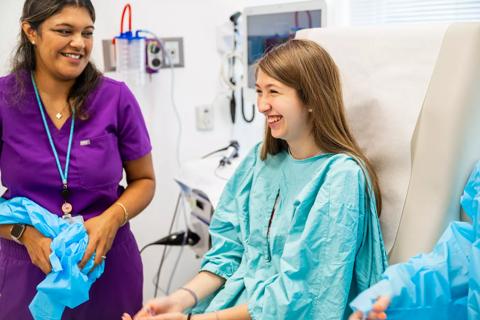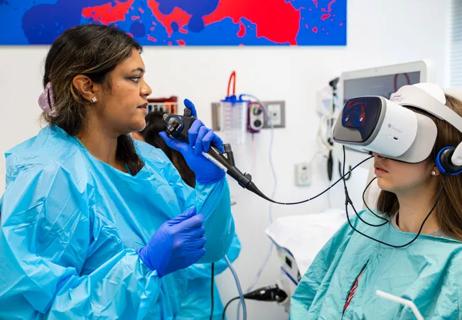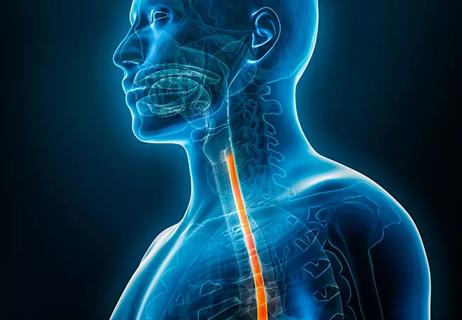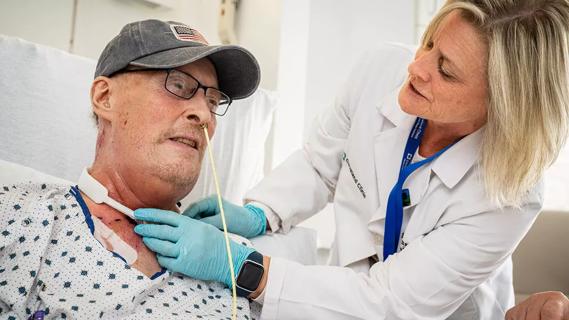Potential for new, non-invasive screening option

Breath tests for volatile organic metabolome compounds have shown promise in diagnosing a variety of gastrointestinal conditions, including irritable bowel disease, acid reflux and colon cancer. Now a pilot study by Cleveland Clinic researchers shows its potential as a diagnostic tool for eosinophilic esophagitis (EoE).
Advertisement
Cleveland Clinic is a non-profit academic medical center. Advertising on our site helps support our mission. We do not endorse non-Cleveland Clinic products or services. Policy
“The approach could mean a new, non-invasive screening option for patients with symptoms of EoE or a tool for monitoring treatment response,” says first author Claire Beveridge, MD, a Staff Member in the Department of Gastroenterology and Hepatology. “By making testing easier and more accessible, it could help patients start treatment sooner.”
Dr. Beveridge continues, “We know that if there’s a diagnostic delay for patients who have EoE that there is then an increased risk of them having fibrostenosis later on, which then becomes more challenging to treat. If there is a non-invasive, less expensive way of screening patients for EoE, that could potentially help reduce the diagnostic delay, making it a little bit easier for patients to access care.”
Currently, the gold standard for diagnosing EoE is endoscopic biopsy. But this procedure is invasive, expensive and requires sedation, which means patients must take the day off from work or school.
Dr. Beveridge understands this can be burdensome for patients, especially when repeated testing is needed to monitor response to therapy. It can also deter some patients from trying an elimination diet to identify triggers, since the process would require them to undergo an endoscopy each time a new food group is introduced.
“It would be nice to have some alternative,” Dr. Beveridge says. “It’s not going to replace upper endoscopy, but it would be an adjunctive way to help screen patients who we think may have EoE and could help assess response to therapy for patients who want to do a diet elimination.”
Advertisement
For the study, researchers looked at adult patients who had symptoms consistent with EoE, excluding people with other conditions that could affect their VOC test results. Of the group, 11 patients had EoE, and 10 did not. Each patient gave a breath sample before undergoing upper endoscopy.
The group found a clear signature for EoE. In addition, the approach also showed promise for identifying patients with more severe disease, including those with significant fibrosis or strictures, Dr. Beveridge says.
Interestingly, in the non-EoE group, researchers also identified biomarkers for GERD, she notes.
While previous research has investigated single compounds as potential biomarkers for EoE, this is the first study to look comprehensively at the hundreds of different organic compounds within the breath and identify a specific chemical signature for the condition.
Next, researchers plan to expand the study to more patients, and will also follow patients longitudinally.
“We want to see how the signature changes when a patient goes into remission on therapy,” Dr. Beveridge says. “What signature do we see of EoE activity versus non-activity versus no EoE at all?”
The study, “The Breath Metabolome Signature Is Linked with Diagnosis of Eosinophilic Esophagitis (EoE): Pilot Study Assessing Exhaled Volatile Organic Compounds (VOCs),” will be presented at Dig
Advertisement
Advertisement

25-year series of over 1,000 patients reveals good long-term palliation, esophageal preservation

Case highlights the benefits of a minimally invasive approach

Pediatric and adult gastroenterologists offer team care for patients with eosinophilic esophagitis

3 pediatric gastroenterologists discuss advances in their diagnostic toolkits

Going beyond the Eckardt symptom score to evaluate dyspepsia, eating and symptom “bother”

Modified Barium Swallow Study and Flexible Endoscopic Evaluation of Swallowing can both be used to diagnose dysphagia, but it’s important to understand their advantages and disadvantages

Microvascular “supercharging” is a critical newer step to promote favorable outcomes

Long-acting antiemetics and high-dose steroids key to minimizing acute nausea